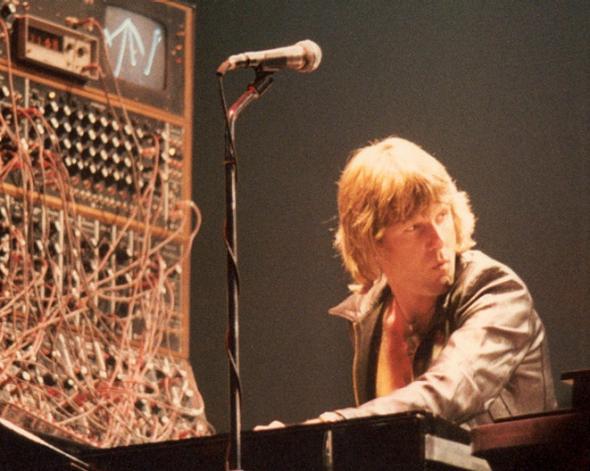Keith Emerson, who might have been the best keyboard player of the rock era, was definitely its first cyborg. Other organists played their instruments; he got intimate with his. He plunged knives into his Hammond in order to sustain notes. He clambered over a Moog synthesizer, yanking and replacing plugs, finding melodies in every confused bleat of circuitry.
In 2016, the electronic music’s conquest feels as inevitable as—well, as the conquest of everything electronic. This afternoon, after Emerson’s death at age 71 was announced, mourners wept at once for the musician himself and for his era, the time when pop music seemed to be composed by people, not factories.
“We lost so many talented people recently,” tweeted Frank Stallone, of all people. “But the no talent worthless scumbags seem to live on.”
Emerson, who was impossibly generous to younger musicians, did not indulge in that sort of thinking. He was an evangelist for classical music and classical training, and for sound-expanding technology, because it had worked for him.
It worked because he had not just talent, but gifts for melody and showmanship. In Beatles-era London, crowded with bands and saturated with hype, the showmanship got noticed first. He credited a mysterious pill and an audience brawl for his decision to mess around onstage.
“I started to throw the organ around and played all this stuff,” Emerson told interviewer Anil Prasad last year. “I went absolutely nuts. The fight stopped. The promoter was standing in the wings yelling ‘Keep going! Keep going!’ Everyone was looking at the stage saying ‘What the hell is this guy doing?’”
When the gimmick ran its course, Emerson could show off his actual talent. He did not simply use the organ for hooks or countermelodies. With his first major band, the Nice, he blended rock instrumentation with quotes from classical music and jazz. Just as Elvis Presley transformed “Blue Moon of Kentucky” from bluegrass in 3/4 time to rock in 4/4 time, Emerson turned “Blue Rondo à la Turk” into the explosive freakbeat of “Rondo.” Emerson’s ear found the link, inaudible to everyone else, from Bob Dylan’s “Country Pie” to Brandenburg Concerto No. 6.
He did all of that before he turned 25. The next phase of Emerson’s career, the supergroup decade he spent with bassist/singer Greg Lake and drummer Carl Palmer, started out even bolder. Intrigued by Wendy Carlos’ Switched-On Bach, her LP of classical music played on a Moog synthesizer, he acquired one of the massive machines and started noodling around. The limits of the organ seemed to have fallen away. “The portamento knob seemed to be a load of fun during the level check,” Emerson recalled in his memoir. “You could slur notes. I made a mental note to use the effect when they ran the tape.”
That was what he did when Lake recorded “Lucky Man,” a simple ballad he’d written as a teenager, and needed a top-off. Electronics were not new to rock music, but they were frequently used to simulate another instrument. Emerson played something otherworldly, and basically accidental. In his own compositions, and in adaptations of standards like “Hoedown” and Pictures at an Exhibition, the orchestra was replaced by the machine, programmable but unpredictable.
Other artists were playing around with the Moog; Emerson was making it the linchpin of arena rock. Accused of pretension, or “taking rock to college,” he was straightforward—he was just taking what he liked, playing around with it, inventing a new music on his way to becoming a composer.
“Pop songs are about repetition and riffs and simplicity,” Emerson explained to one interviewer. “Progressive music takes a riff, turns it inside out, plays it upside down [and] the other way around, and explores its potential.”
That was it. The backlash against progressive rock in the late 1970s—the end of Emerson, Lake, and Palmer was sort of its punctuation mark—was predicated on the idea that this music had throttled creativity and melody. But what in pop music was more daring than a full-length cover of a 10-movement suite from Modest Mussorgsky? For Emerson, who became a sort of elder statesman of electronic music, it was always about melody, always about the sounds no one else had thought to make, with the ingredients no one else knew how to use so well.
